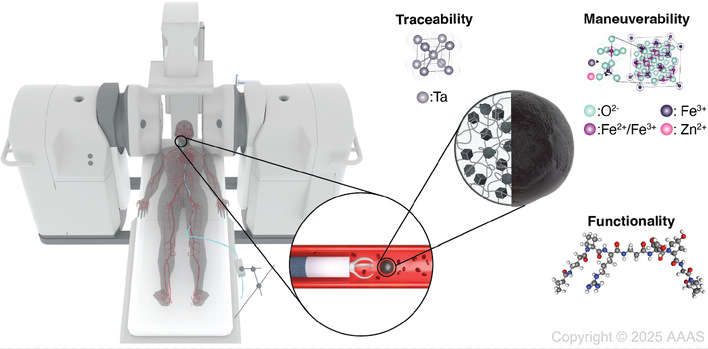近日,国际顶尖期刊Science发表了题为《Clinically ready magnetic microrobots for targeted therapies》的最新研究成果。该研究由瑞士苏黎世联邦理工学院(ETH Zurich)牵头,德国维尔茨堡大学、西班牙巴塞罗那大学、中国复旦大学智慧纳米机器人与纳米系统国际研究院以及义乌研究院等多家单位参与共同完成。其中,我院青年研究员陈相仲在高磁性纳米材料方面作出了关键贡献。
论文系统展示了一个能够在真实临床条件下运行的磁控微机器人平台,实现了从材料、导航系统、影像可视化到靶向释放的多模块整合,首次在工程化程度上接近“临床可用”。平台由双电磁导航系统、特制释放导管以及可降解药物胶囊机器人组成,可在临床工作区域内精准操控微机器人在复杂血管网络中前行。研究团队在猪、羊等大动物模型中完成了导航、定位、药物释放等全流程实验。该成果为未来在脑卒中、难治性肿瘤等临床场景中的应用奠定了坚实基础。作为论文的重要参与者,陈相仲青年研究员带领团队通过精确控制纳米材料的合成过程,大幅改善了磁性纳米颗粒在低操控磁场下磁响应不足的限制,使微机器人在实际临床环境下具备可控性,为本次成果中实现“临床可用”提供了关键的材料基础。

陈相仲青年研究员长期从事磁控微机器人与多场耦合材料研究,目前已在Science、Nature、Nat. Commun.、Adv. Mater.等国际权威期刊发表论文百余篇,并主持包括国家自然科学基金优秀青年基金(海外)在内的多项重大项目。在科研推进的同时,他亦积极开展成果转化工作,打造“智能磁控微机器人”转化项目:有针对性地开发定制化的智能微机器人系统,以满足眼部、胃肠道、颅内等不同部位疾病的精准微创治疗需求,工作包括优化高磁性纳米材料的制备技术、定制化开发智能磁控系统、开发智能控制软件等核心技术单元。目前已申请两项发明专利、一项软件著作权,部分技术已在兔、猪等动物模型中完成验证。团队依托复旦大学智慧纳米机器人与纳米系统国际研究院梅永丰教授团队以及义乌基地,同时与国内外相关研究机构及多家医院保持紧密合作,在材料、导航、介入医学等方面形成了跨学科联合攻关的工作格局。值得一提的是,该成果转化项目与荷兰格罗宁根大学 Sarthak Misra 教授的合作方向已入选第五届“海聚英才”全球创新创业大赛总决赛,并获得海创训练营“量子协作奖”,展现出良好的技术潜力与应用前景。
文章链接:https://www.science.org/doi/10.1126/science.adx1708
Science Publishes Fruit of International Collaboration with Our Hospital: Major Progress in Clinically Viable Magnetically Controlled Microrobots
Recently, groundbreaking research titled Clinically ready magnetic microrobots for targeted therapies was published in Science, one of the world's leading scientific journals. This study was led by ETH Zurich (Swiss Federal Institute of Technology Zurich) and accomplished through a collaboration with multiple institutions, including the University of Würzburg, the University of Barcelona, the Institute of Smart Nanorobotics and Nanosystems at Fudan University, and the Yiwu Research Institute. Dr. Xiangzhong Chen, a young researcher at our hospital, made a critical contribution to the development of highly magnetic nanomaterials for this work.
